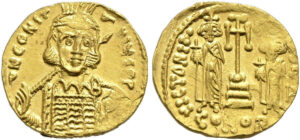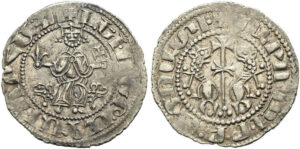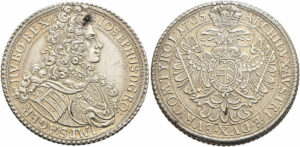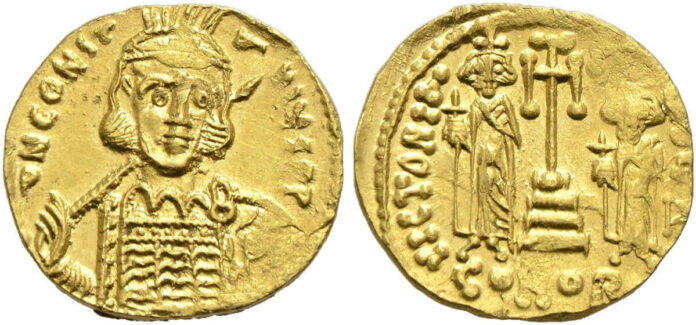Affordable Ancient and Modern Coins at Via
In the seventh e-Live auction, you can look forward to more than 1000 lots from all price ranges from antiques coins to modern coinage.

The rich offer of ancient coins starts with some very beautiful Celtic coins: oboles of the Boii (lots 1-3) and tetradrachms of the Taurisci of the “Augentyp-Stamm” (lots 4-10), the type “Gjurgjevac” (lot 11) and “Samobor“ (lot 12-13). Further coins of the Eastern Celts (Lots 15-18), are followed by many interesting coins from the ancient Greek world, for example from Bruttium (lot 23), Sicilia (lot 24-32), Macedonia (Lot 33-35), Thracia (lot 36- 45), Illyria (lot 46-54), Athens (lot 55, 56-64), the Cimmerian Bosporus (lot 65-70), Pontus (lot 72), Paphlagonia (lot 73), Mysia (lot 74), Ionia (Lot 75), Caria (lot 76), Lycia (lot 77-78), Pamphylia (Lot 79-80), Pisidia (lot 81-82), Cilicia (Lot 83-89), Cappadocia (lot 90-99), as well as Syria (lot 100), Phoenicia (lot 101), Philistia (lot 102), Choresmia-Sogdiana (lot 103-105), Persia (lot 106-107) and Aegyptus (lot 108). From the numerous attractive coins of the Roman Republic (lots 110-176), the anonymous quinarius from 211-208 BC (lot 110), the rare denarii of C. Antestius and Julius Caesar (lot 174), as well as the many lots (Lot 177-197) shall be listed here. A very large selection of coins from the Roman Empire follows. The many appealing denarii of the Flavians (lots 202-207), the adoptive emperors (lots 208-239) and the Severan (lots 243-252) are particularly worth mentioning. The time of the barracks or soldier emperors (lots 253-289) and the Roman late antiquity (lots 290-328) are mainly represented by antoninianii or fractions. Many lots are also be offered in the Roman Empire category. The range of ancient coinage is rounded off by some excellent coins from the Roman provinces (lots 377-425), like the rare drachma of the Lycian League under Augustus (lot 412), the rare bronze coin from Side in Pamphylia by Nero (lot 414), as well as the rare AE issue of Caracalla from Tarsos in Cilicia (lot 416).

In the section of Byzantine coins (lots 426-474) you can expect a large choice of solidi (lots 426-432, 434-438, 440-441, 443-444, 448 and 450) and scyphats (lots 454-459), as well as some plumb seals (Lot 465-468).

The area of the Middle Ages is of course represented again in this auction. Particularly worth mentioning is the larger group of Armenian AR trams by Levon I (lot 477-482), Hetoum I with Zabel (lot 483-492) and Levon II (lot 494-495). In addition to some pieces from the German Middle Ages, including denarii from Jever (lot 506), Emden (lot 507), Speyer (lot 508) and Würzburg (lot 530), pfennige from Bavaria (lot 509-510), and an obol from Bremen (lot 515), as well as French denarii from Strasbourg (lots 553-554 and 568-569), Lorraine (lot 557), Metz (lots 559-561) and Upper Lorraine (lot 562), denarii from Aquileia (lot 636) of the crusaders from Antioch (lot 667-668) or Hungary (lot 768), an AE follaro from Sicily (lot 652), an obol from the diocese of Lausanne (lot 727) and Dutch coins from Utrecht (lot 681-683), Friesland (lot 685 ) and Groningen (lot 690), will also be auctioned, as well as some Austrian, especially Grazer (lot 784-783) and Salzburger pfennige (lot 787-788).
Of the offered coins from all over the world, only the attractive half taler from the imperial city of Kempten (lot 521), the many Sasanians (lots 585-608), the Abbasid dirhams (lots 609-631), and the extremely rare Luigino from Fosdinovo (lot 638), the die for the reverse of a Venetian zecchino from an old counterfeiter’s workshop (lot 658), the rare half-Franco from Avignon of Pope Paul V (lot 662), the Dutch lion thalers (lot 676-680, 686 and 689), the attractive Philippine countermarked 8 reales pieces (lots 695-698), the choice of Spanish ship money (lots 736-748), the Turkish dinars (lots 753-762), as well as the extremely fine Hungarian golden florins of Ludwig I (lot 766) and Matthias Corvinus (lot 767) shall be mentioned here.

Among the coins of the Roman-German Empire, the many 15 Kreuzer of Leopold I (lot 806ff), various thalers of Archduke Ferdinand (lot 790-797), Rudolf II (lot 798-799), Ferdinand II (lot 800), Archduke Leopold (lot 801-802), Ferdinand III (lot 804-805), Leopold I (lot 864), Josef I (lot 872), Charles VI (lot 880 and 883), Maria Theresia (lot 891, 894 and 896-897), Josef II (lot 907) and the Kronentaler from Leopold II (lot 914) and Franz II (lot 917 and 920), as well as the magnificent X Sols piece from the time of the Belgian uprising (lot 913) are particularly worth mentioning.
From the Austrian Empire, along with many other coins, some rare thalers of Franz I (lots 935-936, 942 and 953), a rare AE medal for Ferdinand I as king of Lombardy and Venetia (lot 959), as well as a larger batch of gold coins from Franz Joseph (lot 970ff) are on offer.
Of course, Islamic coins, world coins, coins of the Austrian ecclesiastic principalities and medals, as well as numerous lots (including many with 20 Kreuzer pieces) will be represented in the auction again.
Viewing is possible in the office of Via Numismatic in 1010 Vienna, Habsburgergasse 6-8, Top 17, 3rd floor after prior tel. appointments. Live bidding will begin on Friday, 25th February 2022 at 4.00 PM.
You can find Live-Bidding as well as the auction catalog via the AUEX platform.
Here you can visit the VIA Numismatic website, where you can download the PDF catalog of this auction.



